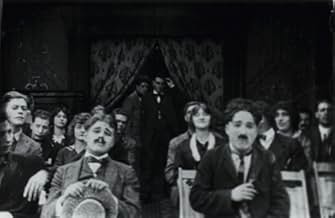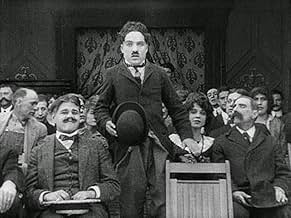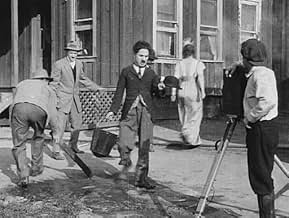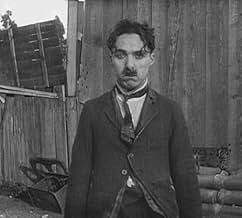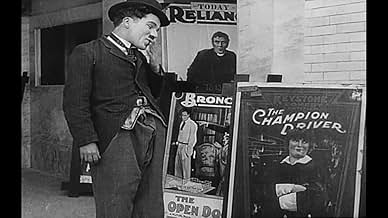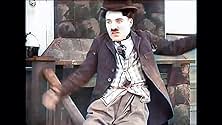IMDb रेटिंग
5.6/10
1.8 हज़ार
आपकी रेटिंग
अपनी भाषा में प्लॉट जोड़ेंCharlie attempts to meet his favorite movie actress at the Keystone Studio, but does not win friends there.Charlie attempts to meet his favorite movie actress at the Keystone Studio, but does not win friends there.Charlie attempts to meet his favorite movie actress at the Keystone Studio, but does not win friends there.
Dan Albert
- Audience Member
- (बिना क्रेडिट के)
Hampton Del Ruth
- Lead Actor
- (बिना क्रेडिट के)
Minta Durfee
- Self
- (बिना क्रेडिट के)
- …
Billy Gilbert
- Theatre Usher
- (बिना क्रेडिट के)
William Hauber
- Audience Member
- (बिना क्रेडिट के)
Bert Hunn
- Audience Member
- (बिना क्रेडिट के)
George Jeske
- Prop Boy in White Shirt
- (बिना क्रेडिट के)
Edgar Kennedy
- Director
- (बिना क्रेडिट के)
Sadie Lampe
- Audience Member
- (बिना क्रेडिट के)
Henry Lehrman
- Self
- (बिना क्रेडिट के)
Hank Mann
- Prop Boy in Overalls
- (बिना क्रेडिट के)
Harry McCoy
- Fireman
- (बिना क्रेडिट के)
- …
George Nichols
- Older Actor on Screen
- (बिना क्रेडिट के)
फीचर्ड रिव्यू
According to some of the central figures involved, including Charlie Chaplin and producer Mack Sennett, Chaplin's first weeks making movies at the Keystone Studio were not pleasant ones. No one knew what to make of this temperamental young Englishman, while Chaplin, for his part, was bewildered by film technique and didn't get along with his colleagues. Though it may seem hard to believe now, there were serious doubts all around that Chaplin could make good in the movies.
Viewed in this light Chaplin's fifth comedy, A Film Johnnie, a fairly amusing short in its own right, takes on some additional historical weight as something of an inside joke, an indirect comment on Chaplin's actual off-screen status at his studio. In the opening sequence a scruffy-looking Charlie goes into a cinema and sees a Keystone comedy featuring an actress he admires. When her co-star, an older man, gets fresh with her Charlie becomes so upset and agitated he is ejected from the theater. He heads straight to the Keystone Studio, seeking to get in. (Thus the title: he's like the "stage door johnnies" who would hang around theaters, hoping to meet the performers and/or get a job with the acting company.) He watches as prominent performers such as Roscoe Arbuckle and Ford Sterling, wearing their street garb, step out of cars and casually enter the studio, smiling and chatting. They're members of the In Crowd, but he is not. Approaching a bemused Arbuckle, he requests and receives a hand-out. He tries this again with Sterling, but -- in a reflection of their alleged off-camera friction? -- receives nothing; Sterling even takes the coin Arbuckle had given Charlie earlier. The studio director (Edgar Kennedy) refuses Charlie admission, but he easily slips past the elderly doorman. Once inside he finds the girl he so admires (Virginia Kirtley) but ruins the scene she's acting in because he believes it's actually happening. He runs amok with a prop pistol, scaring everyone, then leaves.
The comic mayhem that occurs in the studio and at a nearby house fire --which might have been a real event-- amounts to routine Keystone knockabout, apparently improvised while the cameras were rolling. Charlie contributes some cute gags: he lights a cigarette by shooting it with a pistol, and starts to kick a stage hand but when the man turns he quickly switches to scratching his ankle. What's really of interest here is the context and the subtext: essentially Chaplin was still on probation when this film was made, and his colleagues' wariness towards him appears to be genuine. A Film Johnnie captures a time when Charlie hadn't made the grade, just yet.
Viewed in this light Chaplin's fifth comedy, A Film Johnnie, a fairly amusing short in its own right, takes on some additional historical weight as something of an inside joke, an indirect comment on Chaplin's actual off-screen status at his studio. In the opening sequence a scruffy-looking Charlie goes into a cinema and sees a Keystone comedy featuring an actress he admires. When her co-star, an older man, gets fresh with her Charlie becomes so upset and agitated he is ejected from the theater. He heads straight to the Keystone Studio, seeking to get in. (Thus the title: he's like the "stage door johnnies" who would hang around theaters, hoping to meet the performers and/or get a job with the acting company.) He watches as prominent performers such as Roscoe Arbuckle and Ford Sterling, wearing their street garb, step out of cars and casually enter the studio, smiling and chatting. They're members of the In Crowd, but he is not. Approaching a bemused Arbuckle, he requests and receives a hand-out. He tries this again with Sterling, but -- in a reflection of their alleged off-camera friction? -- receives nothing; Sterling even takes the coin Arbuckle had given Charlie earlier. The studio director (Edgar Kennedy) refuses Charlie admission, but he easily slips past the elderly doorman. Once inside he finds the girl he so admires (Virginia Kirtley) but ruins the scene she's acting in because he believes it's actually happening. He runs amok with a prop pistol, scaring everyone, then leaves.
The comic mayhem that occurs in the studio and at a nearby house fire --which might have been a real event-- amounts to routine Keystone knockabout, apparently improvised while the cameras were rolling. Charlie contributes some cute gags: he lights a cigarette by shooting it with a pistol, and starts to kick a stage hand but when the man turns he quickly switches to scratching his ankle. What's really of interest here is the context and the subtext: essentially Chaplin was still on probation when this film was made, and his colleagues' wariness towards him appears to be genuine. A Film Johnnie captures a time when Charlie hadn't made the grade, just yet.
कहानी
क्या आपको पता है
- ट्रिवियाAlthough some sources credit Mack Sennett with playing himself, the film director, the role is actually played by Edgar Kennedy--who, besides being a comic actor, was also a respected director.
- गूफ़Members of the audience behind Charlie Chaplin change - for example, Minta Durfee is sitting behind Chaplin in some shots, but a different actress is seated behind him in others.
- इसके अलावा अन्य वर्जन1930s reissue version, entitled Film Johnny, (released on DVD) omits the opening sequence in the movie theater.
- कनेक्शनFeatured in Crazy Days (1962)
टॉप पसंद
रेटिंग देने के लिए साइन-इन करें और वैयक्तिकृत सुझावों के लिए वॉचलिस्ट करें
विवरण
- रिलीज़ की तारीख़
- कंट्री ऑफ़ ओरिजिन
- आधिकारिक साइटें
- भाषाएं
- इस रूप में भी जाना जाता है
- Charlie the Actor
- फ़िल्माने की जगहें
- उत्पादन कंपनी
- IMDbPro पर और कंपनी क्रेडिट देखें
- चलने की अवधि15 मिनट
- रंग
- ध्वनि मिश्रण
- पक्ष अनुपात
- 1.33 : 1
इस पेज में योगदान दें
किसी बदलाव का सुझाव दें या अनुपलब्ध कॉन्टेंट जोड़ें














